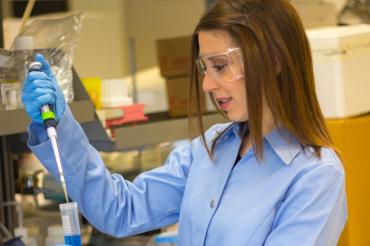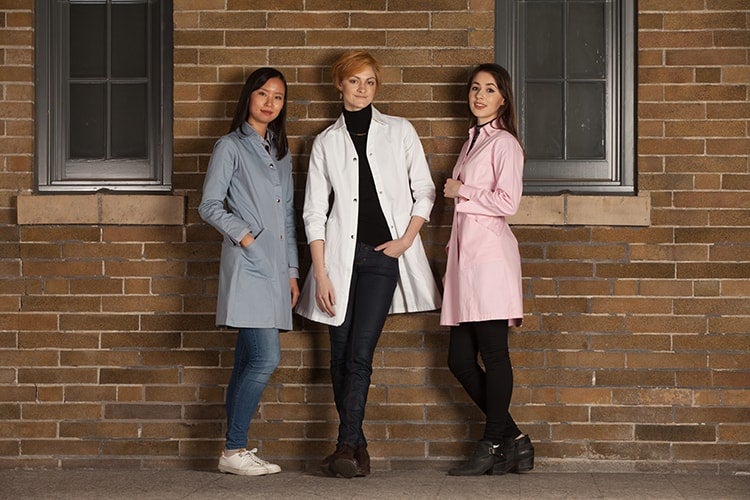Geek to chic: U of T startup reimagines stuffy white lab coats

Published: May 17, 2017
A new startup from the University of Toronto is bringing fashion into the lab.
Created by U of T PhD students Liu Zhang and Ondrej Halgas and Alex Schmidt of Ryerson University, Modadoro is a fledgling fashion line that aims to make frumpy science garb yesterday’s fashion news.
The startup and its labcoats were recently featured in Flare magazine. The coats come in light blue, pink, navy and of course, white, albeit a more stylish version.
“We want to be the Canada Goose of lab coats”
The idea came out of a student project in U of T’s Creating Life Science Products course, taught by Jayson Parker, associate professor, teaching stream who is cross appointed to U of T Mississauga’s master of biotechnology program and U of T’s Institute of Biomaterials and Biomaterial Engineering (IBBME). The year-long graduate course challenges students to identify problems in the life sciences sector and develop a product for commercialization.
For Zhang and her teammates, the problem was outdated, oversized and unfashionable lab coats.
“Our research showed that science students were dissatisfied with current lab coat offerings,” Zhang says. “The current coats are baggy and the sleeves are too big, which is a problem when you’re doing fine and delicate work in the lab.”
A classmate described a bespoke black lab coat he had ordered online, and the team knew they had their project.

“We targeted undergraduate students because they have to buy their own coats,” Zhang says.
U of T Bookstores sell about 3,000 standard cotton-polyester white lab coats to undergraduate science students each year for about $18 each. The team got to work designing a better lab coat and in 2016, Modadoro sold a sample run of 120 coats for women.
The all-cotton Modadoro coats are available are priced at $39 each. Zhang, who is a cancer researcher with the Lunenfeld-Tananbaum Research Institute at Toronto’s Mount Sinai Hospital, acknowledges that the Modadoro coats are a little more expensive but says the difference is in the details.
“Our coats have an interior adjustment feature at the waist and a notched sleeve that is both stylish and functional,” she says.
The coats feature a flared silhouette and angled pockets. The coats also adhere to laboratory safety standards.
“The coat is 100 per cent cotton, so it won’t stick to skin if it catches fire,” Zhang says. “It also has snap buttons so it’s really fast to get off in case of fire or chemical spill.”
Modadoro has had to develop business and marketing plans, design garment prototypes and manage the international manufacturing process, but they say the effort is paying off.
As their second season approaches, they are seeking an investor to help expand Modadoro’s distribution and product line. They are hoping to have about 2,000 coats for sale this fall at several institutions and are testing new designs for men, adding new features, such as cell phone pockets.
“I never envisioned myself working in the fashion industry, but now our goal is to expand the idea and product line as far as possible,” Zhang says. “We want to be the Canada Goose of lab coats. We want to have a strong and recognizable brand known for good quality and fashionable design.”
Zhang tests Modadoro coats in the lab and says a well-fitting garment helps her to feel more professional.
“We’re not just selling a lab coat,” she says. “We’re helping the people who wear the garment to be proud of being scientists."



